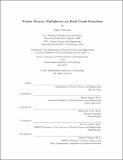Nuclear reactor multiphysics via bond graph formalism
Author(s)
Sosnovsky, Eugeny
DownloadFull printable version (6.540Mb)
Other Contributors
Massachusetts Institute of Technology. Department of Nuclear Science and Engineering.
Advisor
Benoit Forget.
Terms of use
Metadata
Show full item recordAbstract
This work proposes a simple and effective approach to modeling nuclear reactor multiphysics problems using bond graphs. Conventional multiphysics simulation paradigms normally use operator splitting, which treats the individual physics separately and exchanges the information at every time step. This approach has limited accuracy, and so recently, there has been an increased interest in fully coupled physics simulation. The bond graph formalism has recently been suggested as a potential paradigm for reactor multiphysics simulation; this work develops the tools necessary to utilize bond graphs for practical transient reactor analysis. The bond graph formalism was first introduced to solve the multiphysics problem in electromechanical systems. Over the years, it has been used in many fields including nuclear engineering, but with limited scope due to its perceived impracticality in large systems. Bond graph formalism works by first representing a discretized multiphysics system using a group of graph elements, connected with bonds; the bonds transport conserved quantities, and the elements impose the relations between them. The representation can be automatically converted into a state derivative vector, which can be integrated in time. In an earlier work, the bond graph formalism was first applied to neutron diffusion, and coupled to diffusive heat transfer in a 1D slab reactor. In this work, methods are developed to represent, using bond graphs, 2D and 3D multigroup neutron diffusion with precursors, nonlinear point kinetics, and basic nearly-incompressible 1D flow for fully coupled reactor simulation. High-performance, matrix-based bond graph processing methods were developed to support the simulation of medium- and large-scale problems. A pressurized water reactor point kinetics, single-channel rod ejection benchmark problem was used to verify the nonlinear point kinetics representation. 2D and 3D boiling water reactor control blade drop problems were also successfully simulated with the matrix-based bond graph processing code. The code demonstrated 3rd-order convergence in time, a very desirable property of fully coupled time integrators.
Description
Thesis: Sc. D., Massachusetts Institute of Technology, Department of Nuclear Science and Engineering, 2014. This electronic version was submitted by the student author. The certified thesis is available in the Institute Archives and Special Collections. Cataloged from student-submitted PDF version of thesis. Includes bibliographical references (pages 205-216).
Date issued
2014Department
Massachusetts Institute of Technology. Department of Nuclear Science and EngineeringPublisher
Massachusetts Institute of Technology
Keywords
Nuclear Science and Engineering.